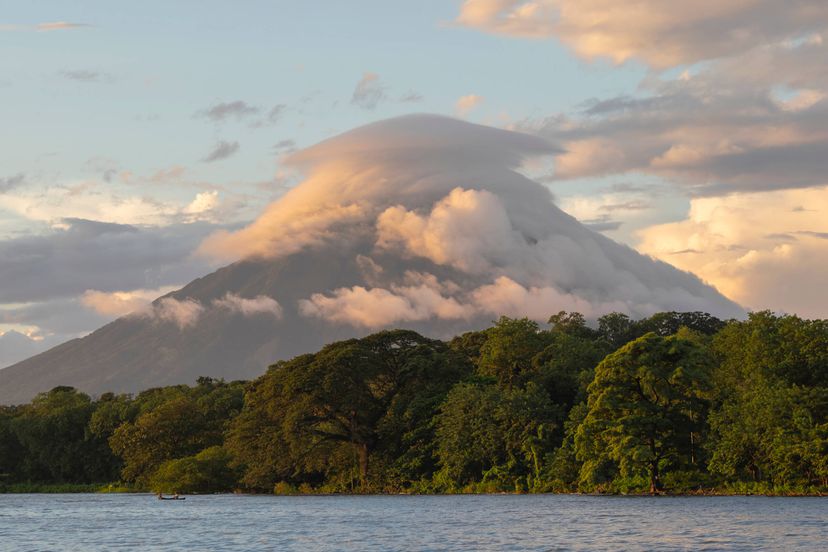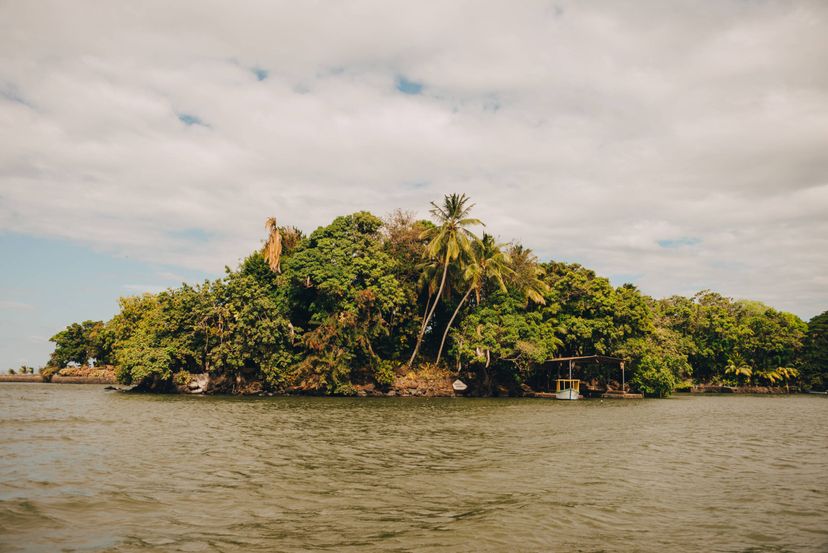
I don’t remember whose bright idea it was to motorcycle around the entire Maderas Volcano that makes up the southern half of La Isla Ometepe, an island in Lake Nicaragua.
Actually, yes I do – it was my boyfriend Keith’s idea. But I can’t really blame him for the jerky three hours that followed, because I readily went along with the idea. Somehow, it never occurred to me to ask a local just how bad those roads are, just how far the circle around the entire southern half of the island went, or just how long it might take us.
Advertisement
Coulda, shoulda, woulda.
We had arrived on Ometepe Island the day before, for our third week in the beautiful Central American country of Nicaragua. After taking the ferry over from San Jorge on the mainland to the town of Moyogalpa, we evaluated our options and decided to rent a motorcycle for our four days on Ometepe.
Ometepe is an amazing place; it was highly recommended to us by many people as soon as we started planning our Nicaraguan travels, and I would just as heartily recommend it to others. It’s like going to an entirely different part of the country; Nicaragua as it perhaps was a half-century ago. It’s very rustic, undeveloped, laid-back, and gorgeous. The name Ometepe means “two hills” in Nahuatl, the original indigenous language, referring to the two active volcanoes, Concepcion on the north and Maderas on the south, that make up the island.

The undeveloped, non-touristy, agricultural charm brings with it challenges, the biggest being how to get around the island. Buses are slow and infrequent, and travelers can wait hours for them. Also, many of the lodgings and fincas (farms such as Finca San Juan de la Isla where we stayed) are several kilometers off the main road, adding even more walking time to your travel time. You can always hire a taxi or personal tour guide, but that gets very expensive – gas is 30% higher here than on the mainland, and arranging for transport every time you want to go anywhere is burdensome. And the roads…well, on much of the island they are extremely hard to navigate. More to come on that…
Ultimately, we decided to rent a motorcycle for $35 per day. This gave us independence and freedom to get around when we wanted, where we wanted.
Advertisement
Perhaps a little too much freedom, as it turned out.
On our first full day exploring the island, we set out from the northern (Concepcion Volcano) side where Finca San Juan is located, to spend the day on the southern half of the island around Maderas Volcano. We started at Finca Magdalena, a 24-family coffee cooperative that also provides lodgings, a restaurant, coffee farming tours and is the main base for hiking up Maderas. After walking around the beautiful gardens and paths there, we hiked the base of the volcano to see the interesting pre-Columbian petroglyphs that are found there. We then settled ourselves on the relaxing open-air porch of Finca Magdalena to enjoy a cup of their damn fine coffee.
We then rode a few kilometers over to Totoco Ecolodge, to check out the self-sustaining lodge and have lunch. We were looking at the map, planning out the rest of our day which theoretically included hiking up to the San Ramon Waterfall on the other side of Maderas.
“Instead of backtracking, why don’t we just continue and make a circle around the entire volcano?” we asked. “After all, how bad can the roads really be?”
We really should have thought about the answer to that question a little more. As it turns out, they can be pretty bad – as in, I’m not sure the term “road” really applies. The paved part of Ometepe, very nicely done with paving stones such as you might use in a backyard patio, made up of about 20 percent of the main road that circles both sides of the entire island.
The remainder of the “main road” varies, between slightly rutted muddy tracks, bouncy dirt and gravel paths, and very long stretches of unbelievably rocky terrain with holes that you could lose a small horse in and rocks the size of the helmet I wore.
But what was really funny to me was how these nicely paved stretches would appear every few kilometers; almost like an oasis, after 15 or 20 minutes of bouncing around crazily, a stretch of sweet, blissfully smooth pavement would appear before us. Just as my bottom was getting used to the nice smooth ride, however, the paved road would end after 10 or 20 feet. And go right back to the potholes and small boulders.
This happened again and again. “Those must be stretches of road that were really bad,” Keith theorized. Which led me to wonder, what do you call the parts we’ve been riding on? It was worse than that? “They probably only had the money to pave over those small parts that were pretty much unnavigable.”
Time stretched on like this. An hour passed, then another. Along the way, we passed the occasional house, a few kids, many horses and pigs, and men with machetes on horseback and in big trucks harvesting the never-ending plantains that makeup one of Ometepe’s biggest exports.
There wasn’t much else out there. It was really interesting at first; then as the hours passed, and I grew sorer and sorer, to the point where it hurt every time I bounced against the seat, it was far less interesting. It devolved into grit-your-teeth-and-bear-it. After three-plus hours, we did finally emerge on the other side of Maderas – exactly where we started. Of course, we completely missed the waterfall or anything else we might have stopped to do. The night was falling, we were sore and tired and hungry, and had spent far more time than we thought circling the island. But the motorcycle did prove the best investment for Ometepe.
Although we smartly avoided repeating the butt-busting tour of Ometepe, over the next few days we explored the island:
- Kayaking on Rio Istian- this small estuary river between the two sides of the island is filled with exotic birds, flowers, reeds, lily pads, and peaceful breezes.
- Visiting the towns of Altagracia and Playo Santo Domingo – where we ate great food, had a few cold beers and rum drinks, and walked around checking out life on Ometepe.
- Hiking through Charco Verde Reserve – this protected parkland is home to several species of howler monkeys, who live in the wild here. We watched families of monkeys in the branches just above our head, playing and eating.
The adventures were good on Ometepe Island, the vibe slow and peaceful, the food terrific and the people warm and friendly. If you are traveling to Nicaragua in the future, I would suggest you not miss this magical place.
Advertisement